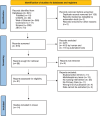Exploring Nursing Interventions for Frail Individuals in Primary Care: A Systematic Review
- PMID: 40536354
- PMCID: PMC12178152
- DOI: 10.1111/inr.70048
Exploring Nursing Interventions for Frail Individuals in Primary Care: A Systematic Review
Abstract
Aim: To report nursing interventions addressing frailty in older adults within primary care settings.
Background: There is a very limited literature corpus on nursing interventions in primary care directed to elderly and frail individuals.
Introduction: Primary care nurses play a key role in providing better care to frail older adults.
Methods: A systematic review was conducted in accordance with the Preferred Reporting Items for Systematic Reviews and Meta-Analyses guidelines, studying the PubMed, Cochrane, Scopus, and JBI databases from September 2013 to August 2023. Two reviewers screened the studies, and three reviewers independently assessed the risk of bias.
Results: Fourteen studies made the final cut. Three categories of interventions were identified: (i) assessments derived from Comprehensive Geriatric Assessments (CGA), such as fall prevention programmes, pain diagnostic evaluations, and assessments of social problems and sociodemographic characteristics, like gender and age; (ii) frailty diagnoses using NANDA terminology; and (iii) nursing care interventions at home and the relationship of trust.
Discussion: Despite the fact that primary care is mainly reactive to the needs of frail elderly individuals, it is also important to be willing to collaborate with them on implementing preventive plans. In the same spirit, establishing a relationship of trust between the health professional and the older adults is a key factor when nursing interventions are carried out in the home of a frail individual. Frailty is a multidimensional concept that is not necessarily linked to age, as studies address frailty starting from the age of 60 and continuing up to 80. But, although frailty is not determined by age, it may be influenced by it.
Conclusion and implications for nursing and health policies: There is no consensus on the starting age for frailty screening or on a single diagnostic tool to identify frailty. Nurses use standardised nursing language related to frailty, both to diagnose it and to implement person-centred care intervention plans. Healthcare policymakers, health organisations, and primary care nurses should consider the findings of this research to evaluate the inclusion of standardised tools to assess comprehensive frailty in older adults. In addition, it is also crucial to prioritise a relationship of trust between individuals and nurses to ensure adherence to nursing care plans.
Keywords: frail elderly; nursing care; primary care; systematic review.
© 2025 The Author(s). International Nursing Review published by John Wiley & Sons Ltd on behalf of International Council of Nurses.
Conflict of interest statement
No conflict of interest has been declared by the authors.
Figures
Similar articles
-
Comprehensive Geriatric Assessment for community-dwelling, high-risk, frail, older people.Cochrane Database Syst Rev. 2022 May 6;5(5):CD012705. doi: 10.1002/14651858.CD012705.pub2. Cochrane Database Syst Rev. 2022. PMID: 35521829 Free PMC article.
-
Home treatment for mental health problems: a systematic review.Health Technol Assess. 2001;5(15):1-139. doi: 10.3310/hta5150. Health Technol Assess. 2001. PMID: 11532236
-
Interventions for preventing abuse in the elderly.Cochrane Database Syst Rev. 2016 Aug 16;2016(8):CD010321. doi: 10.1002/14651858.CD010321.pub2. Cochrane Database Syst Rev. 2016. PMID: 27528431 Free PMC article.
-
Community-based complex interventions to sustain independence in older people, stratified by frailty: a systematic review and network meta-analysis.Health Technol Assess. 2024 Aug;28(48):1-194. doi: 10.3310/HNRP2514. Health Technol Assess. 2024. PMID: 39252602 Free PMC article.
-
Health professionals' experience of teamwork education in acute hospital settings: a systematic review of qualitative literature.JBI Database System Rev Implement Rep. 2016 Apr;14(4):96-137. doi: 10.11124/JBISRIR-2016-1843. JBI Database System Rev Implement Rep. 2016. PMID: 27532314
References
-
- de Salut, D. 2020. Bases conceptuals i model d'atenció per a les persones fràgils, amb cronicitat complexa (PCC) o avançada (MACA). https://hdl.handle.net/11351/7007
-
- Amblàs‐Novellas, J. , Torné A., Oller R., Martori J. C., Espaulella J., and Romero‐Ortuno R.. 2022. “Transitions Between Degrees of Multidimensional Frailty Among Older People Admitted to Intermediate Care: A Multicentre Prospective Study.” BMC Geriatrics 22, no. 1: 1–9. 10.1186/s12877-022-03378-9 - DOI - PMC - PubMed
-
- Bindels, J. , Cox K., De La Haye J., et al. 2015. “Losing Connections and Receiving Support to Reconnect: Experiences of Frail Older People Within Care Programmes Implemented in Primary Care Settings.” International Journal of Older People Nursing 10, no. 3: 179–189. 10.1111/opn.12066 - DOI - PubMed
-
- Bleijenberg, N. , Drubbel I., Schuurmans M. J., et al. 2016a. “Effectiveness of a Proactive Primary Care Program on Preserving Daily Functioning of Older People: A Cluster Randomized Controlled Trial.” Journal of the American Geriatrics Society 64, no. 9: 1779–1788. - PubMed
-
- Bleijenberg, N. , ten Dam V. H., Drubbel I., Numans M. E., de Wit N. J., and Schuurmans M. J.. 2016b. “Treatment Fidelity of an Evidence‐Based Nurse‐Led Intervention in a Proactive Primary Care Program for Older People.” Worldviews on Evidence‐Based Nursing 13, no. 1: 75–84. 10.1111/wvn.12151 - DOI - PubMed
Publication types
MeSH terms
LinkOut - more resources
Full Text Sources
Research Materials


